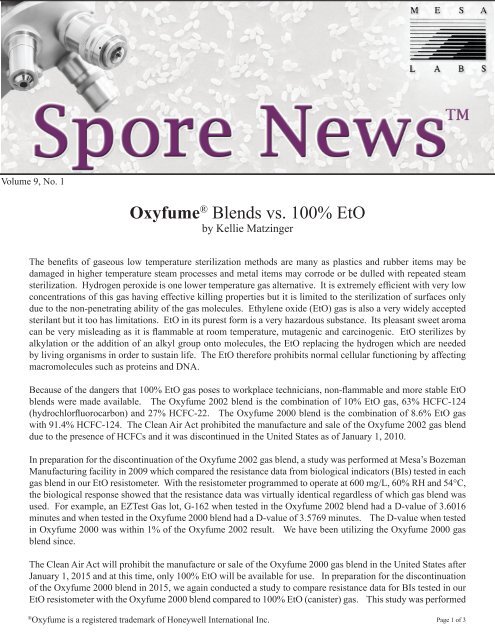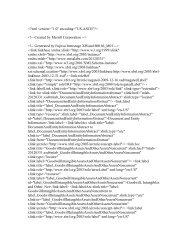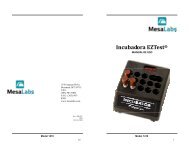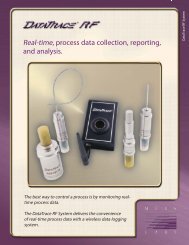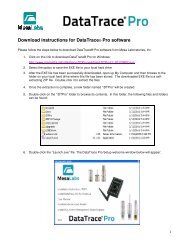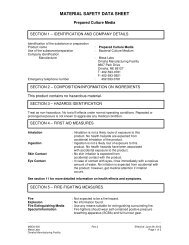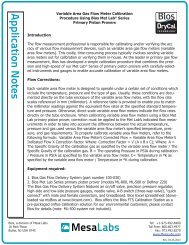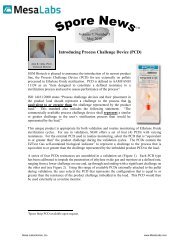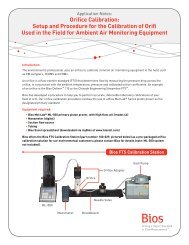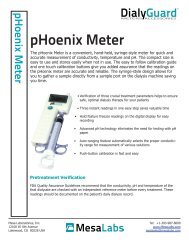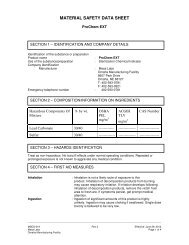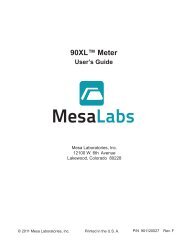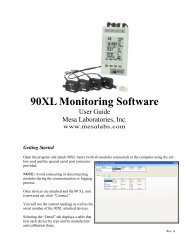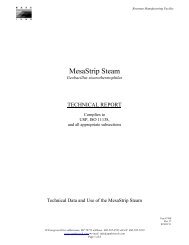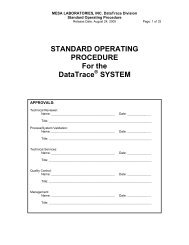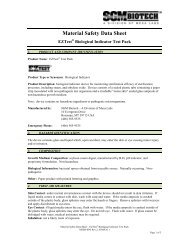Oxyfume® Blends vs. 100% EtO - Mesa Labs
Oxyfume® Blends vs. 100% EtO - Mesa Labs
Oxyfume® Blends vs. 100% EtO - Mesa Labs
Create successful ePaper yourself
Turn your PDF publications into a flip-book with our unique Google optimized e-Paper software.
Volume 9, No. 1<br />
Oxyfume ® <strong>Blends</strong> <strong>vs</strong>. <strong>100%</strong> <strong>EtO</strong><br />
by Kellie Matzinger<br />
The benefits of gaseous low temperature sterilization methods are many as plastics and rubber items may be<br />
damaged in higher temperature steam processes and metal items may corrode or be dulled with repeated steam<br />
sterilization. Hydrogen peroxide is one lower temperature gas alternative. It is extremely efficient with very low<br />
concentrations of this gas having effective killing properties but it is limited to the sterilization of surfaces only<br />
due to the non-penetrating ability of the gas molecules. Ethylene oxide (<strong>EtO</strong>) gas is also a very widely accepted<br />
sterilant but it too has limitations. <strong>EtO</strong> in its purest form is a very hazardous substance. Its pleasant sweet aroma<br />
can be very misleading as it is flammable at room temperature, mutagenic and carcinogenic. <strong>EtO</strong> sterilizes by<br />
alkylation or the addition of an alkyl group onto molecules, the <strong>EtO</strong> replacing the hydrogen which are needed<br />
by living organisms in order to sustain life. The <strong>EtO</strong> therefore prohibits normal cellular functioning by affecting<br />
macromolecules such as proteins and DNA.<br />
Because of the dangers that <strong>100%</strong> <strong>EtO</strong> gas poses to workplace technicians, non-flammable and more stable <strong>EtO</strong><br />
blends were made available. The Oxyfume 2002 blend is the combination of 10% <strong>EtO</strong> gas, 63% HCFC-124<br />
(hydrochlorfluorocarbon) and 27% HCFC-22. The Oxyfume 2000 blend is the combination of 8.6% <strong>EtO</strong> gas<br />
with 91.4% HCFC-124. The Clean Air Act prohibited the manufacture and sale of the Oxyfume 2002 gas blend<br />
due to the presence of HCFCs and it was discontinued in the United States as of January 1, 2010.<br />
In preparation for the discontinuation of the Oxyfume 2002 gas blend, a study was performed at <strong>Mesa</strong>’s Bozeman<br />
Manufacturing facility in 2009 which compared the resistance data from biological indicators (BIs) tested in each<br />
gas blend in our <strong>EtO</strong> resistometer. With the resistometer programmed to operate at 600 mg/L, 60% RH and 54°C,<br />
the biological response showed that the resistance data was virtually identical regardless of which gas blend was<br />
used. For example, an EZTest Gas lot, G-162 when tested in the Oxyfume 2002 blend had a D-value of 3.6016<br />
minutes and when tested in the Oxyfume 2000 blend had a D-value of 3.5769 minutes. The D-value when tested<br />
in Oxyfume 2000 was within 1% of the Oxyfume 2002 result. We have been utilizing the Oxyfume 2000 gas<br />
blend since.<br />
The Clean Air Act will prohibit the manufacture or sale of the Oxyfume 2000 gas blend in the United States after<br />
January 1, 2015 and at this time, only <strong>100%</strong> <strong>EtO</strong> will be available for use. In preparation for the discontinuation<br />
of the Oxyfume 2000 blend in 2015, we again conducted a study to compare resistance data for BIs tested in our<br />
<strong>EtO</strong> resistometer with the Oxyfume 2000 blend compared to <strong>100%</strong> <strong>EtO</strong> (canister) gas. This study was performed<br />
® Oxyfume is a registered trademark of Honeywell International Inc.<br />
Page 1 of 3
with three lots of self-contained biological indicators (SCBIs) from three different manufacturers and two lots of<br />
paper strip BIs packaged in glassine envelopes from two different manufacturers.<br />
The data from this study indicate that the delivery of lethality is quite different for these two supply gases. Despite<br />
the 600 mg/L test condition employed for all exposures, the resistometer cycles run with the <strong>100%</strong> <strong>EtO</strong> canisters<br />
had a higher lethality. As we can see in Table 1, the D-values for the BIs were 25% to 50% lower when the <strong>100%</strong><br />
<strong>EtO</strong> canister was used as the gas supply.<br />
TABLE 1. Resistance data collected on two different types of BIs from three different manufacturers<br />
when Oxyfume 2000 and <strong>100%</strong> <strong>EtO</strong> was used.<br />
Page 2 of 3
The differences in measured D-value are cause for concern if one considers the current published standards<br />
regarding <strong>EtO</strong> BI resistance. Table 2 shows the published resistance values for <strong>EtO</strong> BIs from USP, ISO and EP.<br />
TABLE 2. The requirements for BI D-value when tested in <strong>EtO</strong>.<br />
USP<br />
Chapter <br />
When tested in <strong>EtO</strong> at 600 mg/L, 54°C and 60% RH<br />
D-value of 2.5 to 5.8 minutes<br />
ANSI/AAMI/ISO<br />
11138-2:2006<br />
D-value of not less than 2.5 minutes<br />
EP 7.0 D-value of not less than 2.5 minutes<br />
When comparing the D-value results to the standards, two out of the five D-values calculated for BIs processed<br />
in <strong>100%</strong> <strong>EtO</strong> would have been unacceptable and the other two of the remaining three barely pass at 2.53 and 2.47<br />
minutes.*<br />
It is unknown what caused these significant differences in D-value as the <strong>EtO</strong> resistometer was programmed to<br />
deliver the same concentration of <strong>EtO</strong> regardless of the source gas. We speculate that with the Oxyfume 2000<br />
and Oxyfume 2002 gas blends, the HCFC-124 and HCFC-22 competed with the <strong>EtO</strong> molecule for critical spore<br />
binding sites. This resulted in less alkylation of the molecules within the spores therefore decreasing the lethal<br />
insult delivered in the cycle when compared to the <strong>100%</strong> <strong>EtO</strong>.<br />
As 2015 approaches, BI manufacturers will begin to switch their resistometer supply gas from a blend to <strong>100%</strong>.<br />
Published standards will also need to be revised so the recommended D-values within these documents reflect this<br />
change in test method. As our data showed a 25% to 50% reduction in calculated D-value, perhaps the 2.5 to 5.8<br />
minute range that currently appears should be changed to 1.2 to 4.4 minutes (i.e. 2.5 – 50% ≈ 1.2 and 5.8 – 25%<br />
≈ 4.4).<br />
NOTE: If any of our readers or other BI manufacturers have experienced similar (or contradictory) results to what<br />
we have reported here, we would welcome and appreciate your commentary.<br />
*D-values are rounded to one decimal for label claim.<br />
Kellie Matzinger has been an employee at the Bozeman, Montana <strong>Mesa</strong> Manufacturing Facility for 11 years. Her<br />
first 10 years were spent leading the efforts in the Spore Laboratory where she routinely cultivated bacterial spores<br />
for use in biological indicator products. In April of 2011, Ms. Matzinger made the transition into the Scientific<br />
and Technical Services Department where she currently provides technical assistance and support to customers<br />
regarding biological indicator selection and use.<br />
Ms. Matzinger holds a B.S. in Microbiology from Montana State University.<br />
Page 3 of 3


